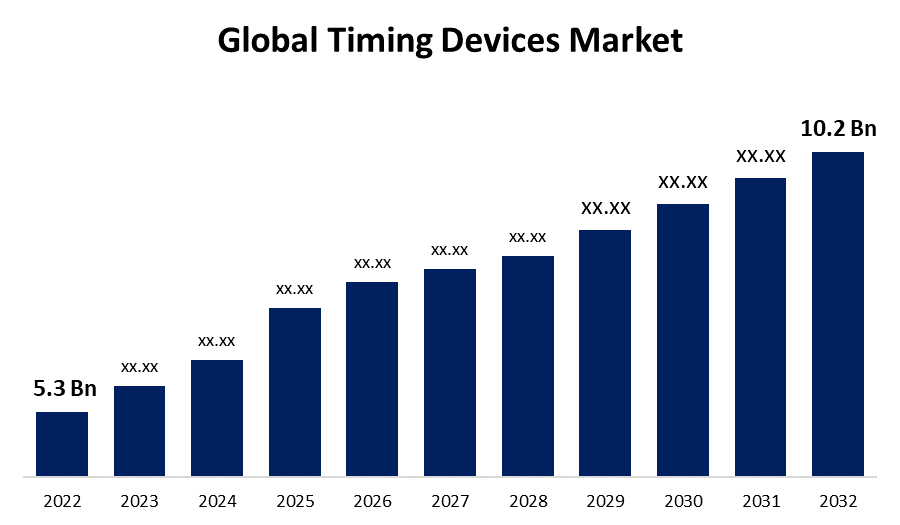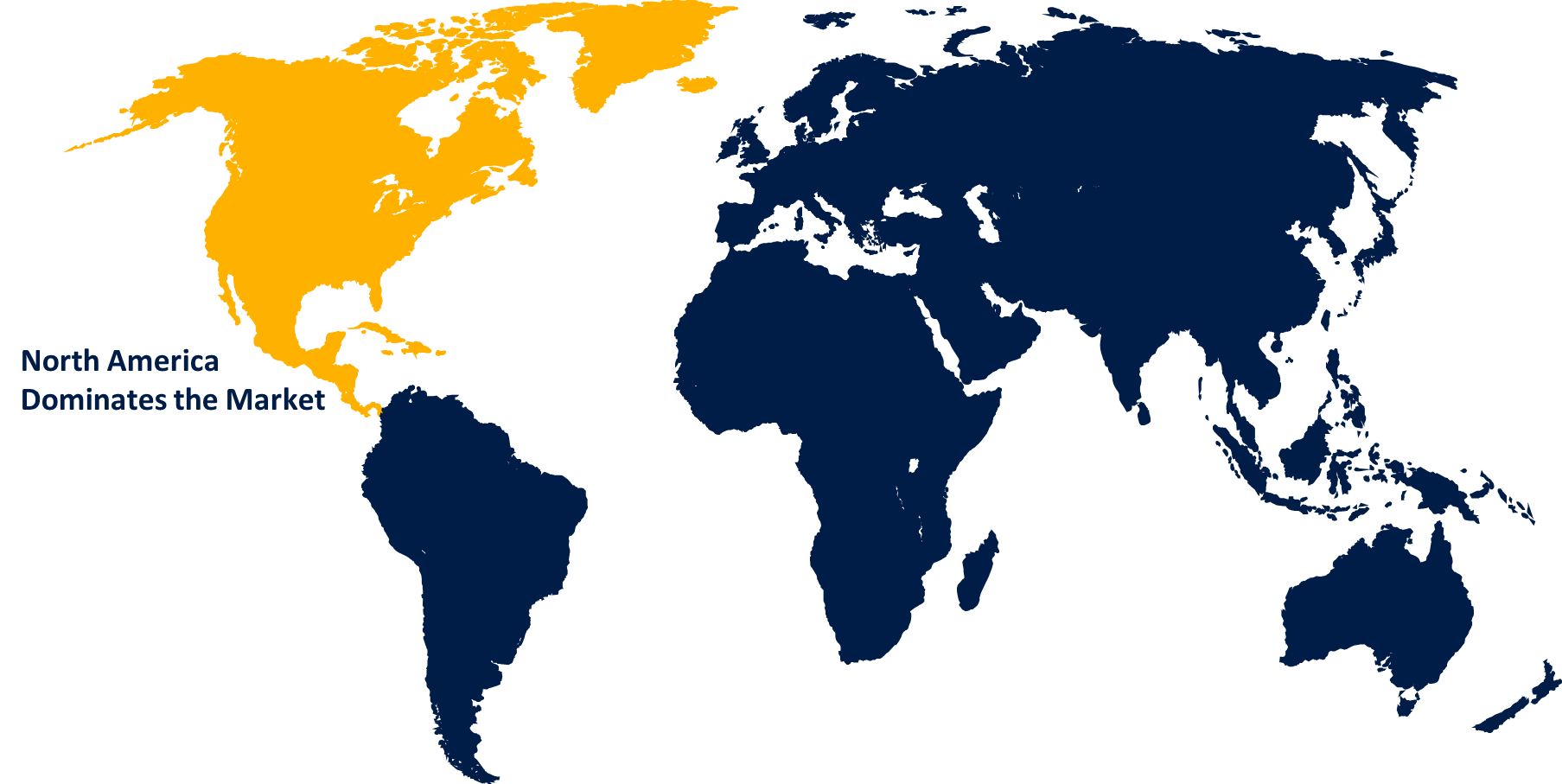Global Timing Devices Market Size, Share, and COVID-19 Impact Analysis, By Type (Oscillators, Atomic Clocks, Clock Generators, Clock Buffers, Jitter Attenuators), By Material (Crystal, Silicon, Ceramic), By Vertical (Consumer Electronics, Automotive, Industrial, Military & Aerospace, and Medical and Healthcare, and Others), and By Region (North America, Europe, Asia-Pacific, Latin America, Middle East, and Africa), Analysis and Forecast 2022 - 2032
Industry: Semiconductors & ElectronicsGlobal Timing Devices Market Insights Forecasts to 2032
- The Global Timing Devices Market Size was valued at USD 5.3 Billion in 2022.
- The Market Size is Growing at a CAGR of 6.8% from 2022 to 2032
- The Worldwide Timing Devices Market Size is expected to reach USD 10.2 Billion by 2032
- Asia Pacific is expected to grow the fastest during the forecast period

Get more details on this report -
The Global Timing Devices Market Size is anticipated to exceed USD 10.2 Billion by 2032, growing at a CAGR of 6.8% from 2022 to 2032. The advancements in the field of telecommunications, increasing usage of timing devices in mobile devices and smart wearables, and increased demand for medical care and health care products drive the expansion of the timing devices market.
Market Overview
Timing devices generate timing signals that allow data to be transmitted at the appropriate time and speed, as well as continuous synchronizing signals. A piece of electronic equipment may contain thousands of components; however, these numerous components are never allowed to run free and must work in tandem to create a certain harmony. The clock contributes to the function of a conductor, the source of which is a timing device. The rising demand for timing devices in healthcare and medical equipment is propelling the timing devices market forward. Timing devices have a variety of costs that necessitate a large capital investment for development, which is a major impediment to the market's growth. The rapid advancement of 5G technology is creating a significant window of opportunity for the growth of the timing devices market. The complexity of adopting rapidly changing technology is posing a significant challenge to the growth of the timing devices market.
Report Coverage
This research report categorizes the market for the global timing devices market based on various segments and regions and forecasts revenue growth and analyzes trends in each submarket. The report analyses the key growth drivers, opportunities, and challenges influencing the timing devices market. Recent market developments and competitive strategies such as expansion, product launch, and development, partnership, merger, and acquisition have been included to draw the competitive landscape in the market. The report strategically identifies and profiles the key market players and analyses their core competencies in each sub-segment of the timing devices market.
Global Timing Devices Market Report Coverage
| Report Coverage | Details |
|---|---|
| Base Year: | 2022 |
| Market Size in 2022: | USD 5.3 Billion |
| Forecast Period: | 2022-2032 |
| Forecast Period CAGR 2022-2032 : | 6.8% |
| 2032 Value Projection: | USD 10.2 Billion |
| Historical Data for: | 2018-2021 |
| No. of Pages: | 200 |
| Tables, Charts & Figures: | 110 |
| Segments covered: | By Type, By Material, By Vertical, By Region and COVID-19 Impact Analysis. |
| Companies covered:: | Seiko Epson Corporation, Nihon Dempa Kogyo Co., Ltd., TXC Corporation, Kyocera Corporation, Rakon Limited, Renesas Electronics Corporation, Infineon Technologies AG, Microchip Technology Inc., Texas Instruments, Abracon, IQD Frequency Products Ltd., NXP Semiconductors N.V., STMicroelectronics, SiTime Corporation, Others, and other key vendors. |
| Pitfalls & Challenges: | COVID-19 Empact, Challenge, Future, Growth, & Analysis |
Get more details on this report -
Driving Factors
People are increasingly turning to electronics or wearable devices to improve their daily lives by tracking fitness, health, and medical behavior. Precision timing is critical for synchronization, data accuracy, and reliable operation in a variety of medical and healthcare applications. Timing devices are suitable for use in diagnostic imaging, magnetic resonance imaging (MRI), wireless telemetry/patient monitoring, ultrasound, computed tomography (CT) scanning, and positron emission tomography (PET) scanning medical equipment. With expanding electronics equipment categories in surgery, radiology, physical medicine, orthopedics, ophthalmology, obstetrics and gynecology, neurology, gastroenterology, urology, and cardiology, the medical electronics or healthcare industry has a high demand for advanced technology products, electronics, and healthcare equipment. As the healthcare industry advances due to the inclusion of various technology-related products, the demand for timing devices rises as they provide greater precision and reliability.
Restraining Factors
The timing devices market, including products like crystal oscillators, clock generators, and timing ICs, has experienced significant growth over the years. As the market matures, saturation in certain segments may lead to increased competition and pricing pressures, limiting the revenue potential for existing players.
Market Segmentation
The Global Timing Devices Market share is classified into type and material.
- The oscillators segment is expected to grow at the fastest pace in the global timing devices market during the forecast period.
The global timing devices market is categorized by type into oscillators, atomic clocks, clock generators, clock buffers, and jitter attenuators. Among these, the oscillators segment is expected to grow at the fastest pace in the global timing devices market during the forecast period. Oscillators are electronic devices that generate repetitive waveforms at specific frequencies, typically sine waves, square waves, or clock signals. They are widely used in a wide range of electronic devices such as computers, mobile phones, communication equipment, and consumer electronics. Oscillators are crucial for maintaining accurate timing and synchronization in electronic systems.
- The crystal segment is expected hold a significant share of the global timing devices market during the forecast period.
Based on the material, the global timing devices market is divided into crystal, silicon, ceramic. Among these, the crystal segment is expected hold a significant share of the global timing devices market during the forecast period. Crystal-based timing devices are widely used in various electronic applications, including oscillators, crystal oscillators (XOs), and temperature-compensated crystal oscillators (TCXOs). Crystal oscillators are known for their precision and are essential for applications where accurate timing and synchronization are critical. These devices find applications in telecommunications, consumer electronics, automotive electronics, and industrial automation.
Regional Segment Analysis of the Global Timing Devices Market
- North America (U.S., Canada, Mexico)
- Europe (Germany, France, U.K., Italy, Spain, Rest of Europe)
- Asia-Pacific (China, Japan, India, Rest of APAC)
- South America (Brazil and the Rest of South America)
- The Middle East and Africa (UAE, South Africa, Rest of MEA)
North America is anticipated to hold a significant share of the global timing devices market over the predicted timeframe.

Get more details on this report -
North America is projected to hold a significant share of the global timing devices market over the predicted years. North America has historically been a significant market for timing devices, driven by the presence of a robust electronics industry, including semiconductor manufacturing and telecommunications. The United States is a key player in this region, with a strong demand for timing devices in applications such as aerospace, defense, telecommunications, and consumer electronics. Technological innovation and adoption of advanced timing solutions are common in this region, making it a dynamic market.
Asia Pacific is expected to grow at the fastest pace in the global timing devices market during the forecast period. The Asia-Pacific region has witnessed rapid growth in the timing devices market due to its role as a manufacturing hub and its increasing consumption of electronic devices. Countries such as China, Japan, South Korea, and Taiwan have a significant presence in semiconductor manufacturing and electronics production. The proliferation of consumer electronics, smartphones, automotive electronics, and industrial automation has boosted demand for timing devices in this region.
Competitive Analysis:
The report offers the appropriate analysis of the key organizations/companies involved within the global timing devices along with a comparative evaluation primarily based on their product offering, business overviews, geographic presence, enterprise strategies, segment market share, and SWOT analysis. The report also provides an elaborative analysis focusing on the current news and developments of the companies, which includes product development, innovations, joint ventures, partnerships, mergers & acquisitions, strategic alliances, and others. This allows for the evaluation of the overall competition within the market.
List of Key Companies
- Seiko Epson Corporation
- Nihon Dempa Kogyo Co., Ltd.
- TXC Corporation
- Kyocera Corporation
- Rakon Limited
- Renesas Electronics Corporation
- Infineon Technologies AG
- Microchip Technology Inc.
- Texas Instruments
- Abracon
- IQD Frequency Products Ltd.
- NXP Semiconductors N.V.
- STMicroelectronics
- SiTime Corporation
- Others
Key Target Audience
- Market Players
- Investors
- End-users
- Government Authorities
- Consulting And Research Firm
- Venture capitalists
- Value-Added Resellers (VARs)
Recent Developments
- In February 2023, RakonXpress is a new brand of off-the-shelf resonators, oscillators, and filters with short lead times from Rakon. Surface Acoustic Wave (SAW) filters and ceramic filters are also available in the Rakonxpress portfolio.
Market Segment
This study forecasts revenue at global, regional, and country levels from 2020 to 2032. Spherical Insights has segmented the Global Timing Devices Market based on the below-mentioned segments:
Global Timing Devices Market, By Type
- Oscillators
- Atomic Clocks
- Clock Generators
- Clock Buffers
- Jitter Attenuators
Global Timing Devices Market, By Material
- Crystal
- Silicon
- Ceramic
Global Timing Devices Market, By Vertical
- Consumer Electronics
- Automotive
- Industrial
- Military & Aerospace
- Medical and Healthcare
- Others
Global Timing Devices Market, By Region
- North America
- US
- Canada
- Mexico
- Europe
- Germany
- Uk
- France
- Italy
- Spain
- Russia
- Rest of Europe
- Asia Pacific
- China
- Japan
- India
- South Korea
- Australia
- Rest of Asia Pacific
- South America
- Brazil
- Argentina
- Rest of South America
- Middle East & Africa
- UAE
- Saudi Arabia
- Qatar
- South Africa
- Rest of Middle East & Africa
Need help to buy this report?